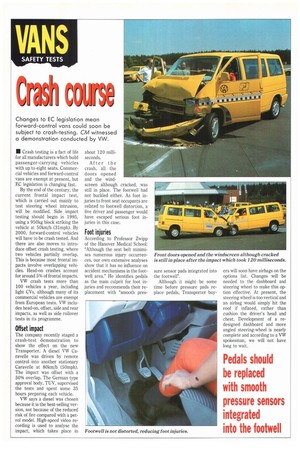crao crirrse
Page 36

If you've noticed an error in this article please click here to report it so we can fix it.
Changes to EC legislation mean forward-control vans could soon be subject to crash-testing. CM witnessed a demonstration conducted by VW.
• Crash testing is a fact of life for all manufacturers which build passenger-carrying vehicles with up to eight seats. Commercial vehicles and forward-control vans are exempt at present, but EC legislation is changing fast.
By the end of the century, the current frontal impact test, which is carried out mainly to test steering wheel intrusion, will be modified. Side impact testing should begin in 1995, using a 950kg block striking the vehicle at 501un/b (31mph). By 2000, forward-control vehicles will have to be crash tested. And there are also moves to introduce offset crash testing, where two vehicles partially overlap. This is because most frontal impacts involve overlapping vehicles. Head-on crashes account for around 5% of frontal impacts.
VW crash tests more than 100 vehicles a year, including light CVs, although many of its commercial vehicles are exempt from European tests. VW includes head-on, offset, side and rear impacts, as well as side rollover tests in its programme.
Offset impact
The company recently staged a crash-test demonstration to show the effect on the new Transporter. A diesel VW Caravelle was driven by remote control into another stationary Caravelle at 80krnth (50mph). The impact was offset with a 50% overlap. The German type approval body, TUV, supervised the tests and spent some 35 hours preparing each vehicle.
VW says a diesel was chosen because it is the best-selling version, not because of the reduced risk of fire compared with a petrol model. High-speed video recording is used to analyse the impact, which takes place in about 120 milliseconds.
After the crash, all the doors opened and the windscreen although cracked, was still in place. The footwell had not buckled either. As foot injuries to front seat occupants are related to footwell distortion, a live driver and passenger would have escaped serious foot injuries in this case.
Foot injuries
According to Professor Zwipp of the Hanover Medical School: "Although the seat belt minimises numerous injury occurrences, our own extensive analyses show that it has no influence on accident mechanisms in the footwell area." He identifies pedals as the main culprit for foot injuries and recommends their replacement with "smooth pres sure sensor pads integrated into the footwell".
Although it might be some time before pressure pads replace pedals, Transporter buy ers will soon have airbags on the options list. Changes will be needed to the dashboard and steering wheel to make this option effective. At present, the steering wheel is too vertical and an airbag would simply hit the roof if inflated, rather than cushion the driver's head and chest. Development of a redesigned dashboard and more angled steering-wheel is nearly complete and according to a VW spokesman, we will not have long to wait.








































































